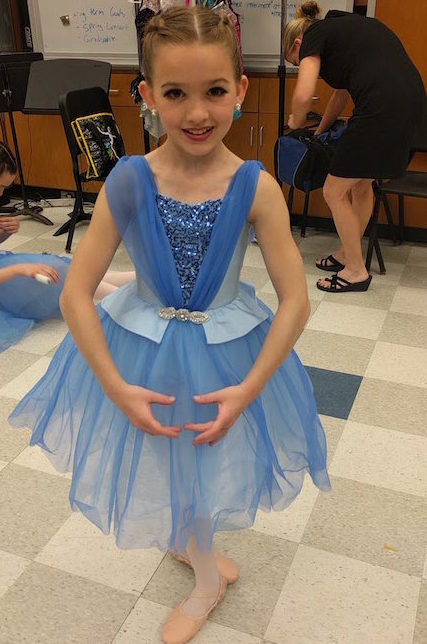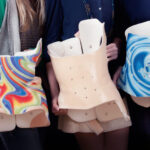Teagan’s triumphant return: Dancing after Perthes disease

Teagan has lived and breathed dance — ballet, jazz, tap, and more — since she was 5 years old. “It’s what makes me happy,” the now 12-year-old says. But two years ago, she started to feel pain in her hip that persisted after dance class and worsened over time. As her spring dance season wrapped up with four shows in two days, Teagan ended the final show with her pain at its worst.
But since her injury didn’t seem to be anything more than a minor muscle pull, her mother Jeannine had Teagan lay low over the summer, hoping that rest would help the pain go away. When dance classes started again in September, her dance teacher noticed that Teagan lacked the flexibility to do the moves she normally could. She recommended that Jeannine take her daughter to Boston Children’s.
A diagnosis of Perthes disease
“We came to Boston Children’s that September,” Jeannine recalls. “They did an x-ray and immediately sent us to Dr. Shore.” Dr. Benjamin Shore, an orthopedic surgeon at Boston Children’s Child & Young Adult Hip Preservation Program, diagnosed Teagan with Legg-Calvé-Perthes disease.
Also known as Perthes disease, this is a condition where the blood supply to the ball-shaped head of the femur becomes temporarily disrupted, resulting in the femoral head collapsing and causing pain and inflammation in the hip joint. Eventually, the blood supply returns and the bone heals, but the shape of the femoral head is no longer normal, so it cannot move smoothly in the hip socket and may limit flexibility.
“What’s challenging in Perthes disease is that the treatment is different for every child, it’s not a cookie cutter approach,” explains Dr. Shore. “With younger patients, we explore conservative methods of treatment, but because Teagan was older, we were concerned her prognosis could potentially be worse. We quickly moved into surgical options in order to give her the best chance to heal and prevent deformity of her hip.”
Hip surgery and recovery
Teagan underwent an arthrogram and femoral osteotomy — two surgeries that would help contain her hip and prevent deformation. Recovery required her to go months without dancing. “For a little girl who dances up to 15 hours a week, being taken off her legs was kind of earth-shattering for her,” says Jeannine.
Treatment for Perthes requires a major reduction in activity in order to limit the damage being done to the hip. With dance being such an important part of her life, it was difficult for Teagan to hear that she would have to be on crutches and then in a wheelchair for months. Recovery seemed so far away.
Both her mom and her doctor remember how hard it was for Teagan to be told of these limitations. “It often seems like it’s the kids who are extra active who tend to get Perthes,” says Dr. Shore. “It can be a big challenge for these kids to limit their activity. But I promised Teagan that she could get back to the things she wanted to do, we just had to follow through with this plan first.”
“As strict as his plan was, he always tried to give her a little light at the end of the tunnel,” Jeannine remembers. “It made everything feel a little better.”
Back on the dance floor
Despite her temporary limitations, Teagan still went to dance class every day. She would take notes as she watched her classmates do what she loved, but was unable to do herself. For each new challenge her treatment brought — from being on crutches before surgery to being in a wheelchair after — Teagan faced it head on. “It was scary at first,” Teagan says. “But once I got used to it I was kind of surprised, because it actually wasn’t that bad.”

Even though she initially felt embarrassed going to school in a wheelchair, Teagan quickly found that her friends were happy to help her with anything she needed. “It made her feel better to know that people were still around, willing to help and take care of her,” says Jeannine.
Teagan had her second surgery in February, to remove the hardware from the first procedure. Just a few weeks later, she made her triumphant return to the dance floor, and participated in her first competition at the end of February.
With a full season of dancing ahead of her, Teagan was back to feeling like herself.
Her resilience and dedication to dance was no surprise to her mom, but certainly left an impact on Dr. Shore. “She never complained and always had a smile on her face” he laughs. “She was just very stoic, especially for someone her age. It was really amazing, I was so impressed by her.”
With her treatment and recovery now in the rearview, Teagan can fully focus her energy on dancing. But when she looks back to when she was facing her surgery and a long recovery, she knows exactly what she would tell herself: “Don’t be afraid!”
Learn more about the Child & Young Adult Hip Preservation Program.
Related Posts :
-

Questions to ask about your child’s orthopedic care
Maybe your child has an orthopedic injury and needs surgery, or maybe they need to be treated with a different ...
-

Engineered cartilage could turn the tide for patients with osteoarthritis
About one in seven adults live with degenerative joint disease, also known as osteoarthritis (OA). In recent years, as anterior ...
-

My story of bouncing back from osteochondritis dissecans
Injuries suck — no better way of putting it. The physical pain is terrible on its own, but emotionally they can ...
-

Predicting brace adherence could change the game in scoliosis treatment
When it comes to preventing scoliosis progression, is it possible to make bracing more effective? For decades, spine specialists focused ...





